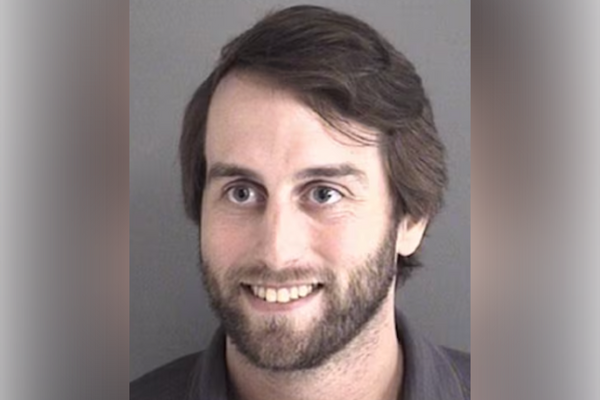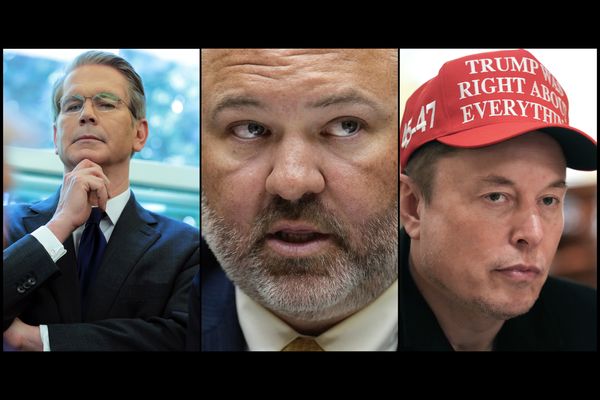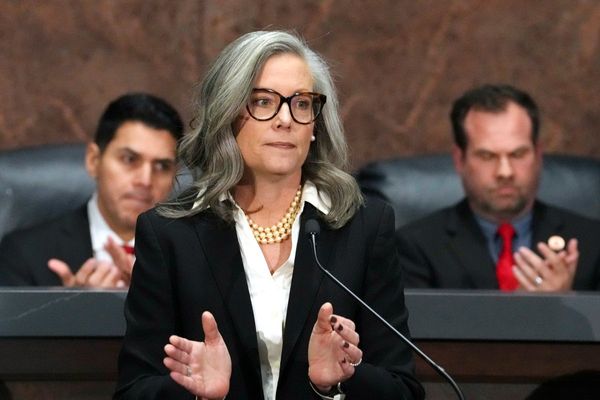
Bigger than the Super Bowl, claimed Donald Trump, sitting in a big leather chair beside a big map. Then came an announcement over the public address system. “Air Force One is currently in international waters,” declared the flight crew of the US presidential jet, “for the first time in history flying over the recently renamed Gulf of America.”
As his aides clapped and whooped, Trump gloated: “Isn’t that nice? We’re about ‘Make America Great Again’, right? That’s what we care about.” He proceeded to sign a proclamation declaring 9 February “Gulf of America Day” as Air Force One flew over the body of water previously known as the Gulf of Mexico.
It was classic Trumpian showmanship from the highest perch in the world. It was also the latest salvo by the 47th president and his allies to control language, influence media narratives and reshape cultural institutions in ways that some compare with the Soviet Union or other authoritarian regimes from history.
Long a master of branding, Trump is making propaganda a core element of his strongman presidency. This comes as little surprise to critics who regard it as an extension of last year’s election campaign in which he sold himself as a champion of the forgotten people and victim of a weaponised justice department.
Tara Setmayer, a former Republican communications director on Capitol Hill, said: “Donald Trump’s re-election is the greatest, most successful propaganda op in history. Propaganda is why Donald Trump is president again and they know this, which is why they undermined the press, expertise and science.”
Since taking office, Trump has outpaced his predecessors by signing 64 executive orders and 27 memos and proclamations in less than a month. His blitz on immigration, trade and the federal bureaucracy was expected. But the president’s aggressive approach to reshaping national identity through symbolism and language has taken opponents by surprise.
When Trump used his inaugural address to assert his vision of US dominance by promising to change the name of the Gulf of Mexico to the Gulf of America, the former secretary of state Hillary Clinton burst out laughing. But the switch came with a sinister edge.
This week, the White House banned the Associated Press, one of the world’s biggest news outlets, because it has not changed its stylebook entry for Gulf of Mexico to Gulf of America (the AP serves numerous countries that do not recognise the new name). The punitive measure prompted CNN to invoke “newspeak” from George Orwell’s novel 1984, in which language is a tool of control and can be narrowed to limit thought.
In a similar vein, the US defense secretary, Pete Hegseth, signed an order restoring the name of a special operations forces base in North Carolina back to Fort Bragg, reversing a Joe Biden effort in 2023 to remove names that honored Confederate leaders (Hegseth swerved past that association by this time recognising Roland Bragg, an obscure veteran of the second world war).
The White House is also redefining terms to cast opponents in a negative light – for example, by referring to fired federal employees as “deep-state activists”. The National Park Service erased references to transgender people on its webpage for the Stonewall national monument.
As the AP discovered, the media – long derided by Trump as “fake news” and “the enemy of the people” – is now subject to a system of rewards and punishments. The owners of the Washington Post and major social media platforms such as Facebook and X had the best seats in the house at his inauguration.
At least 10 of the 18 reporters that the White House press secretary, Karoline Leavitt, called on during her briefing this week work for partisan rightwing outlets. Officials at the Pentagon decided to “rotate” eight major news outlets from their workspaces, replacing them with more Trump-friendly media, and invited a far-right activist, Jack Posobiec, to take part in Hegseth’s first trip overseas.
In addition, Trump is pursuing lawsuits against media outlets by using novel legal theories to circumvent established first amendment protections, while his allies are using the Federal Communications Commission (FCC) to target broadcast news networks whose content they deem unfavorable.
There are concerns that the intimidatory tactics are working. Setmayer, who now leads the Seneca Project, a women-led super political action committee, said: “The mainstream American media has failed. What is happening is not a normal transition; it’s a constitutional crisis. That’s the way the American media should be covering this and they’re not.
“They’re parsing their words. They’re whitewashing and sanewashing what Elon Musk has been allowed to do and what Donald Trump is telegraphing he plans to do more of. They’ve made a business decision to obey in advance. It’s not an accident that Trump went after the FCC licenses and sued these media conglomerates for them to bend their knees to him, so they won’t cover him honestly.”
Trump is also making a surprise foray into arts and culture with a hostile takeover of the John F Kennedy Center for the Performing Arts in Washington, a living memorial for the 35th president that, with a $268m budget last year, hosts classical music, dance, hip-hop, opera, theatre, touring productions and educational arts programming.
Trump has installed himself as chair, stacked the board of trustees with his loyalists and replaced president Deborah Rutter with his former acting director of national intelligence, Ric Grenell, a disrupter who has no prior experience in arts administration.
“We know the importance of the arts in telling stories and keeping the truth out there and in being part of the resistance, so it is no accident that Trump is coming for the arts, similar to other fascists in history,” Setmayer said.
The president admitted he has not been to the Kennedy Center but felt the overhaul was necessary because of drag shows that are “specifically targeting our youth” as well as other “anti-American propaganda”. He told reporters: “We’re going to make sure that it’s good and it’s not going to be woke. There’s no more woke in this country.” In response, several stars have dissociated themselves from the centre.
At the same time, the National Endowment for the Arts, the biggest national funder of the arts and arts education with a budget of $207m in 2024, has cancelled grants aimed at marginalised groups and posted updated guidelines stating that grant recipients should “not operate any programs promoting ‘diversity, equity, and inclusion (DEI)’” or “use federal funds to promote gender ideology”.
The changes fueled concerns about the politicisation of the arts, with critics pointing to examples of dictators in history who suppressed and censored artists.
Olivia Troye, a former adviser to then vice-president Mike Pence, said: “There’s a lot of things I expected from Trump, having worked with his circle of people, but I have to say that it was striking to me when he decided to insert himself and take over the Kennedy Center because that to me was a sign that it is him wanting to fully control all narratives.”
Trump is exhibiting an authoritarian streak and seeking to curb dissent, Troye added: “The arts is a significant pillar of watching what happens in nations that are facing the potential failing of their democracy and that’s concerning. People need to be paying attention to these types of thing.”
“They may seem frivolous: why do I care what he did to the Kennedy Center? Well, let’s look at the history. Who has ever done that as president? Why is he doing that? It’s all part of the overarching effort by this individual who wants to control every narrative there is.”
Like past authoritarians, Trump understands the power of symbols such as Mount Rushmore in South Dakota, which is carved with the faces of former presidents George Washington, Thomas Jefferson, Abraham Lincoln and Theodore Roosevelt. Congresswoman Anna Paulina Luna of Florida proposed legislation adding Trump to the monument, explaining: “President Trump’s bold leadership and steadfast dedication to America’s greatness have cemented his place in history.”
Trump has issued an order to revive a “National Garden of American Heroes”, an attempt to curate a version of history that reinforces ideas of national exceptionalism. The representative Buddy Carter of Georgia has introduced a bill to rename Greenland as “Red, White, and Blueland”, as Trump seeks to acquire the island territory.
Trump has also called for “patriotic education”, attempting to control what is taught in schools and instil a conservative vision. The administration is pushing to restrict what teachers can teach about gender and race and has threatened to withhold funds from schools that fail to comply.
Above all, the 47th president is dominating the nation’s attention, filling news cycles and social media 24 hours a day, seven days a week. Last Sunday, he became the first sitting US president to attend the Super Bowl, the crown jewel of US sport, which drew a record 127 million viewers and “a Caesar-at-the-Colosseum air,” according to New York Times critic James Poniewozik.
Then, when Trump hosted ally Elon Musk and his son X in the Oval Office, there was saturation coverage. White House communications director Steven Cheung tweeted an image of eight news networks simultaneously broadcasting the meeting and boasted: “FULL SPECTRUM DOMINANCE.”
Reed Galen, president of the Union, a pro-democracy coalition, said: “With dictators throughout history, it’s all spectacle. The idea of propaganda is not necessarily to lie about things but to keep the attention focused where you want it, and he’s a master of that.”
Ruth Ben-Ghiat, a history and Italian studies professor at New York University and author of Strongmen: Mussolini to the Present, describes Trump as “one of the most successful propagandists in all of history”, as skilled as the former Italian dictator Benito Mussolini in his use of images, symbols and repetition.
She said: “The cult of personality is that you must be omnipotent but you’re also omnipresent, you’re everywhere. It’s not just old-school dictatorships like North Korea today or communist China where the face of the leader is everywhere.
“Nowadays, for example, Modi in India is the most followed leader in the world. He’s a genius at Instagram. When he ran for office in 2014, he used holograms so he could be in a hundred places at the same time. Being everywhere and inescapable is part of making the population depend on you and on no one else.”







